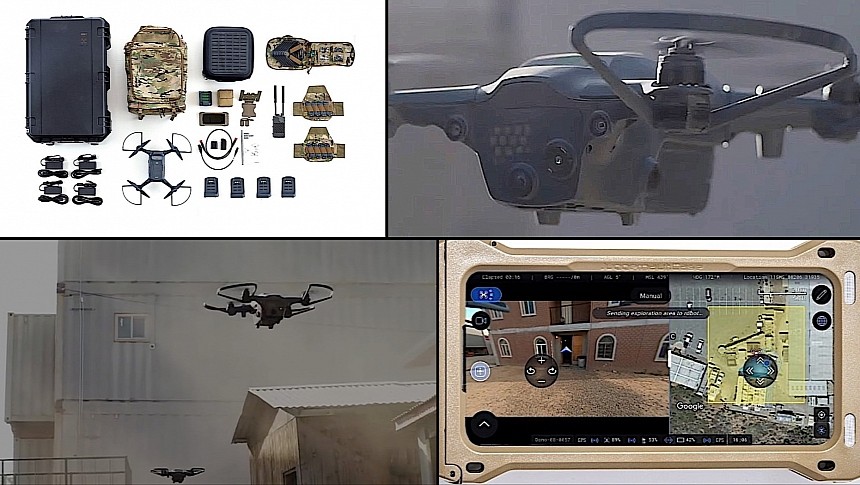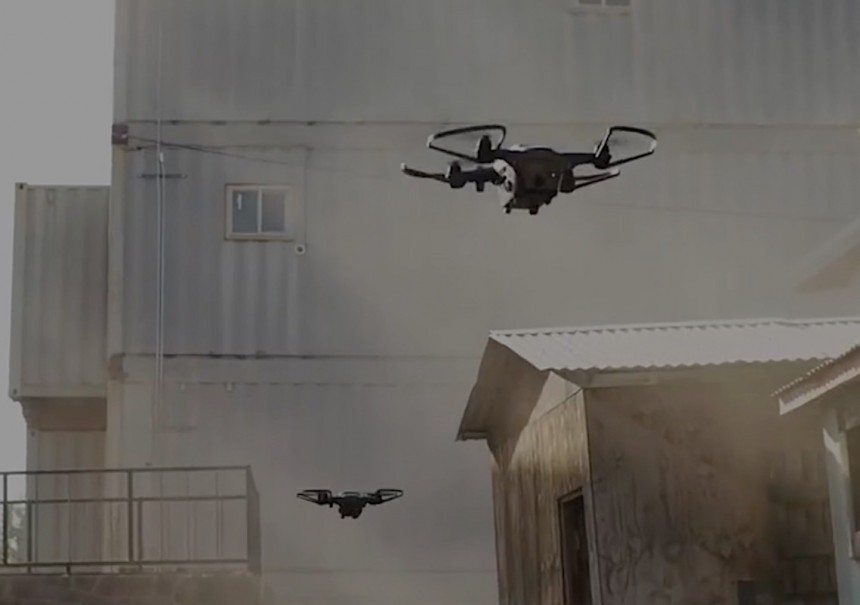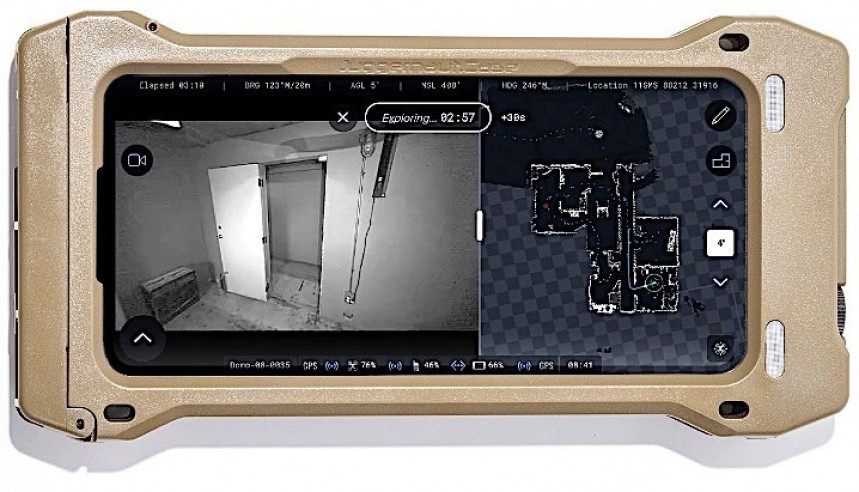The most recent conflict the world has to navigate, the one in Ukraine, is the perfect setting for the world's powers to test their most advanced weapons systems. There's a lot going on over there in this respect as fighting rages between Ukrainian and Russian troops, but there is no doubt the tech making the biggest impact comes in the form of drones.
Remotely operated, these machines are used by both sides for anything from target acquisition to actual bombing, and there seem to be few ways to stop drones from achieving their goals. A large variety of them is constantly flying in the skies of the European country, but almost all of them have something in common: they still need human operators.
The Hivemind-powered Nova 2 is, to our knowledge, not part of the war in Ukraine. It's a brand new piece of tech that's only beginning to make its presence felt, developed by a California-based company called Shield AI.
At the core of the machine is something called the Hivemind, a type of AI that should give the drone incredible capabilities, including the ability to run without any communication with a ground station, no human to control it, no GPS to find its way, and no previously-set waypoints. Let's see how.
The exact specs (dimensions, power source, and so on) of the thing are not public, but we're in essence looking at a quadcopter like so many others out there. The difference is this one is equipped with a variety of sensors and other payloads, mounted either above or below its body, which it uses to map and search any building of interest for friendly troops.
Shield AI says the Nova 2 uses computer vision so great it's capable of outperforming even the best human drone pilots. And that's all owed to the Hivemind AI system mentioned earlier.
The company is delivering the drone to those interested in using it (but not civilians, obviously), complete with spare batteries, prop guards, and the needed propellers. The thing is, if you like, combat-ready as soon as you take it out of the box (or backpack).
The most recent news concerning the Hivemind came our way earlier this year, when we learned of Shield AI being asked by defense contractor Kratos to supply the Hivemind for the Valkyrie drone it is working on.
Hivemind first came into the spotlight back in 2018 as the "first and only autonomous AI pilot." It immediately captured the attention of the American military, which asked for tests of the tech to be conducted against top-notch U.S. Air Force (USAF) and U.S. Navy pilots.
The details of the simulated dogfights using F-16s are not known, but we do know the results: in 99 percent of scenarios, including the DARPA AlphaDogfight Trials, the AI managed to beat its human opponents.
When deployed, the drone detects and highlights entryways in a building, and can head in through either a window or a door. The only thing the operator has to do is to select the point of entry, and then the drone does everything else on its own.
While on mission, the Nova sends back images in either electro-optical or infrared forms (thermal vision is also available).
When it detects hostiles, the drone auto-populates both 2D and 3D maps that are accessible by the crew it is meant to support, with vibration notifications being sent out as well so that soldiers are aware threats have been found.
The current capabilities of the drone are likely to be expanded greatly in the future, as the machine and its brain continue to be bettered. First on the agenda are plans are to make the Nova 2 capable of supporting launch commands from hundreds of miles away.
As it continues to prove its worth in small machines such as this one, the Hivemind will probably grow to fully control more complex weapons' platforms, and that's when things will likely become really interesting.
The Hivemind-powered Nova 2 is, to our knowledge, not part of the war in Ukraine. It's a brand new piece of tech that's only beginning to make its presence felt, developed by a California-based company called Shield AI.
At the core of the machine is something called the Hivemind, a type of AI that should give the drone incredible capabilities, including the ability to run without any communication with a ground station, no human to control it, no GPS to find its way, and no previously-set waypoints. Let's see how.
The Drone
The Nova 2 arrived in 2021 and is officially described as an indoor drone, meaning it's of the small variety meant for use in urban settings. It appears it is already deployed in the service of several armed forces, as according to its maker it has already brought "service members home safely to their families."The exact specs (dimensions, power source, and so on) of the thing are not public, but we're in essence looking at a quadcopter like so many others out there. The difference is this one is equipped with a variety of sensors and other payloads, mounted either above or below its body, which it uses to map and search any building of interest for friendly troops.
The company is delivering the drone to those interested in using it (but not civilians, obviously), complete with spare batteries, prop guards, and the needed propellers. The thing is, if you like, combat-ready as soon as you take it out of the box (or backpack).
The Hivemind Brain
Hivemind is officially a software ecosystem with an AI at its core. It's a piece of tech designed to power not only drones, but "every military asset: aircraft, drones, ships, satellites and submarines."The most recent news concerning the Hivemind came our way earlier this year, when we learned of Shield AI being asked by defense contractor Kratos to supply the Hivemind for the Valkyrie drone it is working on.
Hivemind first came into the spotlight back in 2018 as the "first and only autonomous AI pilot." It immediately captured the attention of the American military, which asked for tests of the tech to be conducted against top-notch U.S. Air Force (USAF) and U.S. Navy pilots.
The details of the simulated dogfights using F-16s are not known, but we do know the results: in 99 percent of scenarios, including the DARPA AlphaDogfight Trials, the AI managed to beat its human opponents.
Nova 2 Operation
In the Nova 2 the Hivemind system makes the presence of any human in the area for control purposes useless. The AI gives the drone the ability to plan its own course, navigate around obstacles and in multi-story buildings, and generally be badass. Again, all of that without having access to GPS and comms, if need be, and without being controlled by a human pilot.While on mission, the Nova sends back images in either electro-optical or infrared forms (thermal vision is also available).
When it detects hostiles, the drone auto-populates both 2D and 3D maps that are accessible by the crew it is meant to support, with vibration notifications being sent out as well so that soldiers are aware threats have been found.
The current capabilities of the drone are likely to be expanded greatly in the future, as the machine and its brain continue to be bettered. First on the agenda are plans are to make the Nova 2 capable of supporting launch commands from hundreds of miles away.
As it continues to prove its worth in small machines such as this one, the Hivemind will probably grow to fully control more complex weapons' platforms, and that's when things will likely become really interesting.












